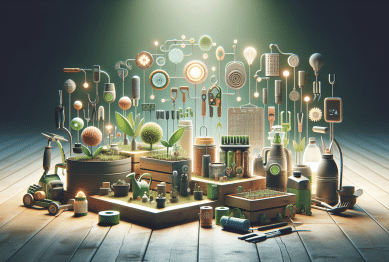Kitchen gadgets and appliances have become nearly as numerous as the ingredients in our favorite recipes. From high-end blenders to specialized utensils, the choices seem endless. However, the movement toward owning fewer but better kitchen tools is gaining momentum, and for good reason. A minimalist approach not only saves valuable kitchen space but also promotes efficiency and enhances the cooking experience. Let’s explore why owning fewer, better kitchen tools can be more practical and sustainable than accumulating a multitude of gadgets that ultimately get pushed to the back of the cupboard.

Why Quality Over Quantity?
When it comes to equipping your kitchen, it’s tempting to believe that more tools mean more convenience. Yet, many kitchen tools are designed to serve one specific purpose and can quickly become clutter. Here are several key reasons why owning fewer, better kitchen tools is an ideal choice for modern home cooks.
1. Maximized Efficiency
Investing in high-quality, versatile tools reduces the need for numerous single-purpose gadgets. For instance, a good chef’s knife can replace a host of smaller knives, while a multipurpose food processor can handle everything from chopping vegetables to kneading dough. This streamlining of equipment not only saves time but also reduces decision fatigue in the kitchen.
2. Better Performance
While cheaper kitchen tools may seem appealing due to their lower price point, they often don’t hold up over time. The quality of materials, craftsmanship, and design play a significant role in a tool’s performance and longevity. A premium chef’s knife, for example, will maintain its sharpness longer and cut more precisely, making meal prep smoother and more enjoyable.
3. Sustainability
Investing in fewer, better kitchen tools also benefits the environment. Instead of purchasing multiple low-quality items that wear out and end up in landfills, purchasing high-quality items that can last decades contributes to reducing waste. By focusing on durable tools, you can build a sustainable kitchen that requires fewer replacements and has less impact on the environment.
4. Space-Saving
For those with limited kitchen space, clutter can quickly become overwhelming. A kitchen filled with specialized tools might seem practical at first, but it can quickly lead to disorganization. Fewer tools mean more counter and cabinet space, making your kitchen more functional and easier to navigate. Plus, this space-saving approach ensures that your best tools are always within reach.
5. Easier to Maintain
Maintaining kitchen tools can be a time-consuming task, but it becomes much easier when you have fewer items to care for. With fewer tools, it’s simpler to clean, sharpen, and repair what you have. Instead of worrying about the upkeep of dozens of gadgets, you can focus on keeping your few essential items in top condition.
The Essentials: What to Keep in Your Kitchen?
To embrace the concept of fewer, better kitchen tools, it’s essential to focus on the key items that will serve multiple functions and provide long-term value. Below is a list of some of the most versatile tools that should be the cornerstone of every kitchen.
1. Chef’s Knife
A high-quality chef’s knife is the most essential tool in any kitchen. It can handle virtually every task from chopping to slicing, making it the ultimate workhorse in your kitchen. Look for a knife that feels balanced in your hand and stays sharp over time.
2. Cast Iron Skillet
A cast iron skillet is not only incredibly durable but also versatile. It can be used on the stovetop, in the oven, and even on the grill. Over time, the seasoning on the pan enhances its non-stick properties, making it even more valuable as it ages.
3. Cutting Board
A sturdy cutting board is necessary for any kitchen, and choosing one made of durable materials like wood or bamboo ensures longevity. This tool is essential for protecting your knives and preventing damage to your countertops.
4. High-Quality Blender
A high-powered blender is essential for making everything from smoothies to soups. A versatile blender can also handle tasks such as crushing ice, making nut butter, and even kneading dough, making it an indispensable part of a minimalist kitchen.
5. Measuring Tools
Accurate measurements are essential for most recipes. Investing in a reliable set of measuring cups and spoons ensures that your dishes turn out as intended. Look for stainless steel or glass options that are durable and easy to clean.
6. Multi-Purpose Food Processor
A good food processor can replace a range of tools, including a grater, slicer, and mixer. It’s a must-have for anyone looking to streamline their kitchen tools while saving time during meal prep.
7. Heavy-Duty Pot or Dutch Oven
A high-quality Dutch oven is perfect for braising, stewing, and baking. Its versatility and ability to retain heat make it an excellent choice for long cooking sessions and one-pot meals.
Embracing Minimalism in the Kitchen: A Trend on the Rise
Minimalism, once mostly associated with fashion and interior design, has made its way into the culinary world. Influential chefs and food bloggers are now emphasizing the importance of pared-down kitchen setups, focusing on quality rather than quantity. According to experts, fewer kitchen tools lead to more creativity in cooking. With fewer distractions, home cooks can focus on mastering a few key techniques, rather than relying on gadgets to do the work.
In fact, many high-end chefs prefer simple, high-quality tools to gimmicky gadgets. This minimalist approach aligns with the trend of slow cooking and mindful eating, where the focus is placed on the quality of ingredients and the craft of cooking rather than the quantity of tools used.
How to Start Reducing Your Kitchen Inventory?
Making the transition to fewer, better kitchen tools doesn’t have to be overwhelming. Here are a few steps to help you get started:
- Assess Your Current Inventory: Start by taking stock of the tools you currently own. Look for duplicates and items that are seldom used. Do you really need a garlic press and a zester, or can your chef’s knife handle both tasks?
- Prioritize Versatility: Choose tools that serve multiple purposes. Instead of buying specialized tools for every task, opt for those that can be used in various cooking techniques.
- Invest in Quality: Once you’ve narrowed down your selection, focus on investing in high-quality tools. While the upfront cost might be higher, the durability and performance will pay off in the long run.
- Let Go of Unused Tools: Donate or sell tools that you rarely use. This not only frees up space but also ensures that these items go to someone who will get more use out of them.
- Maintain What You Have: Take good care of the tools you decide to keep. Regular maintenance, such as sharpening knives and cleaning equipment, will ensure that they last for years to come.
Conclusion: Less is More
Owning fewer, better kitchen tools allows you to simplify your cooking process, save time, and reduce clutter. Instead of accumulating a vast array of gadgets, focus on quality, versatility, and durability. With the right tools, you can elevate your cooking experience, all while embracing a minimalist approach that enhances both your kitchen and your life.
References:
- “The Best Chef’s Knife for Your Kitchen” – NY Times Wirecutter. This guide explores the importance of investing in a good-quality chef’s knife, how to choose one, and the performance advantages of high-end knives. Available at: https://www.nytimes.com/wirecutter/reviews/best-chefs-knife/
- “The Case for Minimalist Kitchens” – The Kitchn. This article discusses how minimalism in the kitchen can lead to a more enjoyable and efficient cooking experience by using fewer, higher-quality tools. Available at: https://www.thekitchn.com/the-case-for-a-minimalist-kitchen-231964
- “Why a Cast Iron Skillet Is a Must-Have Kitchen Tool” – Bon Appétit. Bon Appétit shares why cast iron skillets are some of the best kitchen investments, highlighting their durability and versatility in cooking. Available at: https://www.bonappetit.com/story/why-you-should-own-a-cast-iron-skillet









